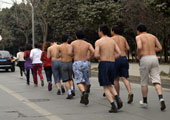
Flow of labor
Lu called this a strategy of "productivity flattening through agglomeration".
"When the free flow of labor, land and capital is constrained, the homogeneous industrial structure between different regions is inevitable," he added.
"When each province has a similar industry structure, it is natural for them to segment into local markets and prevent as much local capital from flowing to other places."
Lu's own research has found that the more radically a local government acts in regional protectionism, the faster economic growth it can generate. This is how the "prisoner's dilemma" works.
It may seem to be in their best interests to keep the Chinese market fragmented and to practice regional protectionism.
But when everyone resorts to radical protectionism, overall national economic growth suffers.
China's economies of scale would be compromised if its eastern provinces lost their competitive edge in the global market, and its urbanization process slowed in terms of numbers and quality.
According to Lu, the restricted flow of labor has held back China's urbanization process.
The country's ongoing urbanization process is expected to generate tremendous domestic demand.
But its urban ambitions will not be realized unless major reforms are made to integrate its markets, and allow a freer flow of labor.

















 Surrealistic impression shown in fog
Surrealistic impression shown in fog


![]()
